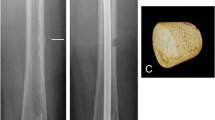Abstract
Objective
We studied the callus features seen in cases of regenerate fracture in femoral lengthening using a monolateral fixator in achondroplasia to determine whether callus types and shapes can predict the probability of callus fracture.
Materials and methods
The radiographs of 28 cases of femoral lengthening in 14 patients, 14 cases of callus fracture, and 14 cases without callus fracture were retrospectively analyzed by four observers and classified into different shapes and types in concordance with the Ru Li classification.
Results
The average lengthening of 9.4 cm (range 7.5–11.8 cm) was achieved, which was 41% (range 30–55%) of the original length and the average timing of callus fracture was 470 days (range 440–545 days) after surgery in the callus fracture group. While the average lengthening of 9.1 cm (range 8–9.7 cm) was achieved, this was 30% (range 28–32%) of the original length in the group of patients without callus fracture. The callus was atypically shaped, there was a 48% average (range 30–72%) reduction of the callus width compared with the natural width of the femur, and a lucent pathway was present in all cases of regenerate fracture.
Conclusion
A lucent pathway was seen in all fracture cases with concave, lateral, and atypical shapes, and there was more than 30% lengthening and 30% reduction of the callus width compared with the natural width of the femur, which are the warning signs for regenerate fractures. These signs help the surgeon to predict the outcome and guide him in planning for any additional interventions. The Ru Li classification is an effective method for the evaluation of the chance of callus fracture.




Similar content being viewed by others
References
Young JWR, Kostrubiak IS, Resnick CS, Paley D. Sonographic evaluation of bone production at the distraction site in limb lengthening procedures. Am J Roentgenol. 1990;154(1):125–8.
Eyres KS, Bell MJ, Kanis JA. New bone formation during leg lengthening. J Bone Joint Surg Br. 1993;75:96–106.
Maffulli N, Cheng JCY, Sher A, Ng BK, Ng E. Bone mineralization at the callotasis site after completion of lengthening. Bone. 1999;25(3):333–8.
Minematsu K, Tsuchiya H, Taki J, Tomita K. Blood flow measurement during distraction osteogenesis. Clin Orthop Relat Res. 1998;347:229–35.
Li R, Saleh M, Yang L, Coulton L. Radiographic classification of osteogenesis during bone distraction. J Orthop Res. 2006;24(3):339–47.
Vade A, Eissenstat R. Radiological features of bone lengthening procedures. Radiology. 1990;174:531–7.
Minty I, Maffuci N, Hughes TH, et al. Radiographic features of limb lengthening in children. Acta Radiol. 1994;35:555–9.
Donnan LT, Saleh M, Rigby AS, et al. Radiographic assessment of bone formation in tibia during distraction histiogenesis. J Pediatr Orthop. 2002;22:645–51.
Orbay JL, Frankel VH, Finkle JE, et al. Canine leg lengthening by Ilizarov technique. Clin Orthop Relat Res. 1992;(278):265–73.
Hamanishi C, Yasuwaki Y, Kikuchi H, et al. Classification of the callus in limb lengthening. Radiographic study of 35 limbs. Acta Orthop Scand. 1992;63(4):430–3.
Codivilla A. On the means of lengthening, in the lower limbs, the muscles and tissues which are shortened through deformity. Clin Orthop Relat Res. 1994;(301):4–9.
Zarzycki D, Tesiorowski M, Zarzycka M, Kacki W, Jasiewicz B. Long term results of lower limb lengthening by the Wagner method. J Pediatr Orthop. 2002;22(3):371–4.
Hood RW, Riseborough EJ. Lengthening of the lower extremity by the Wagner method. A review of the Boston Children’s Hospital Experience. J Bone Joint Surgery Am. 1981;63(7):1122–31.
Dahl MT, Gulli B, Berg T. Complications of limb lengthening. A learning curve. Clin Orthop Relat Res. 1994;(301):10–8.
Karger C, Guille JT, Bowen JR. Lengthening of congenital lower limb deficiencies. Clin Orthop Relat Res. 1993;(291):236–45.
Siffert RS. Lower limb-length discrepancy. J Bone Joint Surg Am. 1987;69(7):1100–6.
Kawamura B, Hosono S, Takahashi T. The principles and technique of limb lengthening. Int Orthop. 1981;5(2):69–83.
Yun AG, Severino R, Reinker K. Attempted limb lengthening beyond twenty percent of the initial bone length: results and complication. J Pediatr Orthop. 2000;20(2):151–9.
Paley D. Current techniques of limb lengthening. J Pediatr Orthop. 1988;8:73–92.
Kojimoto H, Yasui N, Goto T. Bone lengthening in rabbits by callus distraction. The role of periosteum and endosteum. J Bone Joint Surg Br. 1988;70:543–9.
Ilizarov GA. Clinical application of the tension stress effect for limb lengthening. Clin Orthop Relat Res. 1990;(250):8–26.
Paley D, Fleming B, Catagni M, Kristiansen T, Pope M. Mechanical evaluation of external fixators used in limb lengthening. Clin Orthop Relat Res. 1990;(250):50–7.
Paley D. Problems, obstacles, and complications of limb lengthening by the Ilizarov technique. Clin Orthop. 1990;(250):81–104.
Catagni M. The radiographic classification of bone regenerate during distraction. London: Williams & Wilkins; 1991. p. 53–7.
Ilizarov GA. The principles of Ilizarov method. Bull Hosp Joint Dis. 1988;48:1–11.
Paley D. The Ilizarov corticotomy. Tech Orthop. 1990;5:41–52.
Frankle VH, Gold S, Golyakhovsky V. The Ilizarov technique. Bull Hosp Joint Dis. 1988;48:17–27.
Bowen JR, Levy EJ, Donohue M. Comparison of knee motion and callus formation in femoral lengthening with the Wagner or monolateral ring device. J Pediatr Orthop. 1993;13:467–72.
Acknowledgements
This study was supported by a grant of the Korea Healthcare Technology R&D project, Ministry for Health, Welfare and Family Affairs, Republic of Korea (A080588). Authors thank to Mrs. Prakruti K. Devmurari for her assistance in writing manuscript, preparing the diagramatic illustration and stastical analysis as well for the article.
Author information
Authors and Affiliations
Corresponding author
Rights and permissions
About this article
Cite this article
Devmurari, K.N., Song, H.R., Modi, H.N. et al. Callus features of regenerate fracture cases in femoral lengthening in achondroplasia. Skeletal Radiol 39, 897–903 (2010). https://doi.org/10.1007/s00256-009-0742-6
Received:
Accepted:
Published:
Issue Date:
DOI: https://doi.org/10.1007/s00256-009-0742-6




